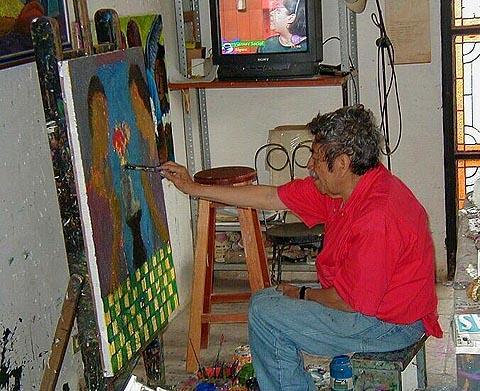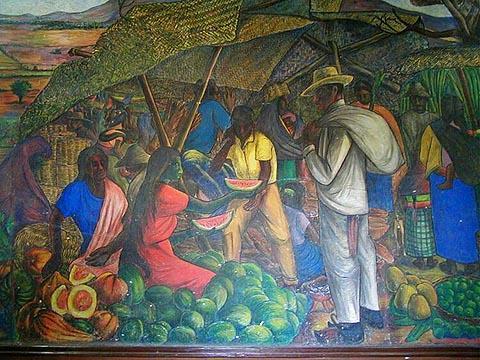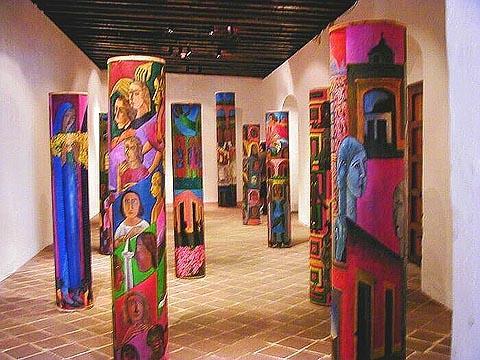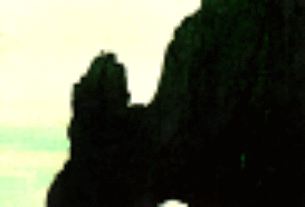In the seven years that I have lived in Oaxaca, I have often caught glimpses of the Maestro working in his studio; run into him at various cultural functions; and crossed his path on the street. His life and his works have had an affect on my life here, far greater than our nodding acquaintance would suggest (he probably didn’t even know my name). For me, and a great many others, Morales embodied not only Oaxacan culture, but Oaxacan civility and civic responsibility as well.

A Zapotec, born of working class parents, in a small town near Ocotlan de Morelos, a regional market town about 30 miles from Oaxaca city, Maestro Rodolfo rose to be a very wealthy man, with paintings being displayed in major galleries throughout the world. Many who have had his talent and good fortune turned their back on their roots, but not Rodolfo.
The Zapotec traditions include a commitment to sharing good fortune with others. The Zapotec word for this social service, transliterated into Spanish, is “Tequio”. It is similar to tithing, where labor may substitute for money. In the poorest villages, it is how the roads and the schools get built: everyone gives some labor (or money) to a common project to benefit the community. Rodolfo gave a lot of tequio, far more than was required, but, he acknowledged at one project innauguration I attended, far less than was needed.
His contributions, mostly through a foundation he set up in later years, includes the renovation of fifteen churches and cultural spaces throughout the municipio of Ocotlan. The flagship of this fleet is the church and ex-convent in Ocotlan itself, a dazzling and exquisitely tasteful complex which hosts a gallery, a restaurant, and spaces for meetings, performances and classes.

There is a permanent staff of architects and other experts overseeing all the projects, but each and every project hires local young people, mostly women, to do the work of restoration. We were fortunate enough to spend some time with one of these young women, working on restoring a church in the town of Zagache, Ocotlan. When her work with the restoration project is over, she will be a qualified antiquities restorer, able to get work anywhere. This project has opened up the world to her.
Morales gave his house in Ocotlan, a colonial house, to the Casa de Cultura (state culture ministry) of Oaxaca. Aside from the beautiful garden, and the Maestro’s studio, it contains a computer classroom. The Maestro noted, a few years ago, that computers were the future, and immediately bought a roomful so the local youth could learn.
Much of the house is a sort of museum, housing Rodolfo’s collections of china, stained glass, furniture and bric-abrac; similar to Frieda’s house, and Trotzky’s house, and Abe Lincoln’s. The center of this obra (work) is, in fact, in back and on the second floor: a three-room walk-through that contains the master’s studio.

Every Friday morning, Rodolfo could be found there, painting. In the far room, surrounded by tubes of oil paint, open jars of wash, and in the last couple of years a television set, the master demonstrated to friend and stranger alike, the techniques he used to create the unique canvases that made him famous. We visited him there just three weeks ago, along with a family of friends from California.
Working on five or six pieces at once, Morales answered questions, posed for pictures, and generally played the humble host. Only the humility wasn’t put on. Rodolfo was, in bearing, manner, and presence, a truly humble person. Walking down the street in Oaxaca, he reminded me of a small-town grocer or hardware store owner.
All this past month, the Museo de Arte Contemporanéo de Oaxaca (MACO; the modern art museum) has dedicated its entire second floor to a retrospective of the maestro’s works, from a very “realistic” picture of a drunken campesino sleeping it off on a pile of refuse, to a group of cylendrical “pillars” of painted canvas.
An “out” homosexual, he gave much to the effort to control the spread of AIDS. Currently, some sixty of his prints are for sale by the Frente Común Contra SIDA (common front against AIDS), having been donated by Rodolfo to help them raise needed funds.
I don’t know much about art, and so I leave all that to those who do. We don’t own any of his works, mostly because they are a little too costly for us. Still, I will miss Rodolfo Morales a lot. His life and his works, both artistic and charitable, touched mine directly. I am better off for the contact.

